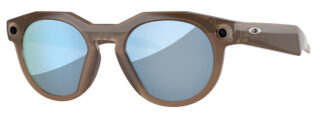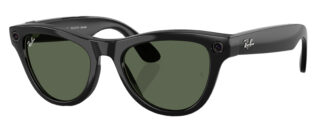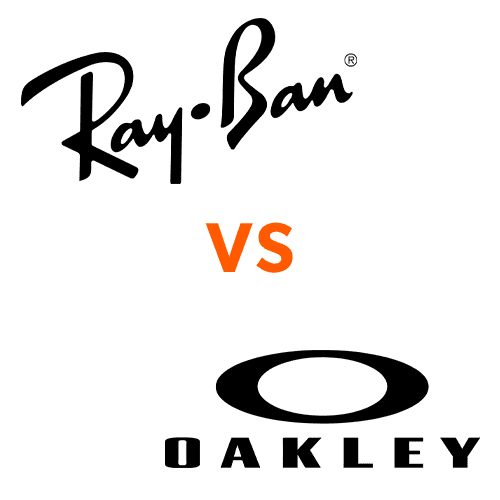- Safety Glasses
- Sports
- Sunglasses
- Eyeglasses
- Safety Products
- Accessories
- Resources



Smart eyewear is changing fast, and with new technology, it’s evolving into something accessible for many consumers. Artificial intelligence (AI)-powered smart glasses from Meta are now available as Oakley Meta HSTN and Ray-Ban Meta. These two glasses are built with Meta’s AI technology and the power of EssilorLuxottica’s frame expertise.
Each brand takes its own unique, fashion-forward approach to merging AI technology with the performance needs of sunglasses. The Oakley Meta HSTN is sporty and performance-driven, while the Ray-Ban Meta is classic, with a fashion-forward hipster vibe. This Meta glasses review compares the two styles to help you decide which pair best fits your lifestyle.
Not sure which brand to choose? Follow this guide to compare Ray-Ban Meta vs Oakley Meta glasses.
Ray-Ban’s smart glasses build on the legacy of iconic frames like the Wayfarer, Skyler, and Headliner. These heritage sunglasses prioritize fashion and versatility to work with multiple looks, with the added edge of smart technology. By integrating tech into familiar silhouettes, these AI sunglasses are more approachable for those who are prioritizing fashion, versatility, and everyday aesthetics.
Oakley’s design is less about fashion and more about performance. With motorcyclists and athletes in mind, these AI sunglasses are built for durability and designed for comfort, featuring a sports-tuned fit. The new glasses follow in the footsteps of Oakley’s high-performance legacy, and they are seen as the “new gold standard” for smart glasses, according to Android Central. These glasses, which came out two years after the Ray-Ban Meta glasses, have the same Meta AI features but last up to 70% longer and have improved video stabilization features at 1080p.
Deciding which of these glasses is best for you starts with a technical comparison. Looks alone won’t define a good pair of smart glasses.
For those who enjoy taking photos or videos, comparing the camera and video quality is important.
The Ray-Ban Meta features a 12 MP ultra-wide camera and supports 1440 × 1920 video at 30 fps.
The Oakley Meta HSTN glasses also feature a 12 MP ultra-wide camera, but stand out with the addition of the 3K (~2300 × 3100px) video recording option and the ability to record longer due to a superior battery.
Both the Ray-Ban Meta and Oakley Meta HSTN glasses have open-ear speakers and a five-microphone array. When considering audio quality, the two brands are comparable, so you’ll need to look at other factors to guide your decision.
Battery life makes a big difference in how you use your AI sunglasses. Ray-Ban Meta glasses offer about four hours of run time per charge, which can be extended up to 36 hours with the case.
The Oakley Meta HSTN glasses double that and give you up to 8 hours of use, 19 hours on standby, and up to 48 hours with the charging case. Additionally, these glasses are fast-charging and can be charged to 50% within about 20 minutes.
Processing speeds and connectivity designs are similar for both pairs.
Both Oakley and Ray-Ban have made their glasses fully compatible with iOS and Android.
Weight can make or break long-term comfort. Wearing heavy glasses can lead to pain and irritation, but light ones can feel like you’re not wearing anything at all. The Ray-Ban glasses weigh in at approximately 49 grams (although this does vary by style), thanks to their classic acetate-like frames, making them the lighter option. The Oakley glasses weigh around 53 grams, built with lightweight O-Matter frames and sport-centric dimensions. Their extra grams may be attributed to the slightly larger battery, giving you longer use in exchange for a heavier frame.
Both brands of AI glasses offer IPX4 splash resistance that is ideal for light water exposure, getting caught in rainstorms, or even boating on the open ocean.
When it comes to Oakley Meta glasses vs. Ray-Ban Meta glasses, both support prescription customization, but their lens technologies differ slightly.
Both support prescription lenses, including clear, sunglass tints, and Transitions. They can handle prescription lenses between -6.00 and +4.00.
Oakley has some unique benefits over Ray-Ban if you’re looking for upgraded features. The limited edition collection boasts Prizm 24K polarized lenses, with plans to have those available for prescription ranges between -6.00 and +4.00 in fall 2025.
Both Ray-Ban and Oakley glasses support high-index, glass, polycarbonate, and Trivex materials. Prescription lens options include single vision, lined bifocals, and progressives.
Glasses aren’t worth much if the visual experience isn’t great. Fortunately, both of these AI glasses have a lot to offer.
Exclusively created for Oakley, the PRIZM polarized lenses enhance contrast and deliver clarity. These lenses are especially valuable for outdoor sports and performance activities.
The Ray-Ban Meta glasses maintain classic aesthetic lens options with Rx support, plus retro tint styles for added flair. If fashion is your game, the Ray-Ban Meta delivers a visual experience that complements your personal style.
| Feature / Attribute | Ray-Ban Meta | Oakley Meta HSTN |
| Style Direction | Classic, fashion-forward | Sport / Performance-oriented |
| Camera & Video | 12 MP, 1440×1920 video | 12 MP, 3K video, longer record times |
| Audio & Mic | Open-ear speakers, 5-mic array | Same layout |
| Battery (Glasses / Case) | ~4 h / ~36 h | ~8 h / ~48 h, fast-charge |
| Processor & Connectivity | Snapdragon AR1 Gen1, Wi-Fi 6, BT 5.3 | Same specs |
| Weight & Frame Material | ~49 g; standard frames | ~53 g; O-Matter, more rugged frame |
| Water Resistance | IPX4 splashproof | IPX4 splashproof |
| Lens Tech | Standard tints; future Rx options | PRIZM Polarized; upcoming Rx options |
| Prescription Support | Yes (–6 to +4 expected) | Yes (–6 to +4, with Oakley-specific styles) |
| Battery Performance | Adequate | Superior for longer use |
| Best For | Everyday use, style, broad appeal | Active lifestyles, outdoor clarity, extended wear |
Here’s a quick review of some of the key points to consider when deciding on which pair is right for you:

Camera and Battery: Oakley’s 3K capture and doubled battery life make it superior for extended outdoor use, which is ideal for running, cycling, and long recording sessions.

Lens and Visual Clarity: Oakley’s PRIZM lenses enhance color and contrast, giving an advantage in bright, variable environments.

Style and Customization: Ray-Ban shines in style variety, colors, and everyday wearable appeal. Oakley focuses on performance and sport-tailored design.

Prescription Versatility: Both brands offer strong Rx support, but Oakley adds performance-oriented tint technology.

Overall Trade-Off: Choose Ray-Ban Meta for style, value, and versatility, or Oakley Meta HSTN for performance, durability, advanced video, and superior battery life.
AI is a powerful technology that can change the way you live your life. And with AI glasses, you’ll have artificial intelligence with you every step of the way.
But with such iconic options that both support prescription customization and advanced lens materials, which pair is right for you? Go with the Ray-Ban Meta if you want tradition, timeless style, and broad everyday appeal. Pick the Oakley Meta HSTN if you prioritize active performance, higher tech, longer battery, and higher video quality.
External Resources:
The Oakley Meta HSTN are the new gold standard for smart glasses
Oakley Meta HSTN: Are the Prizm lenses worth it?
RESEARCH NOTE: Ray-Ban Meta Smart Glasses Review: Better, Cooler, and More Useful Than Ever
Oakley Meta HSTN smart glasses review: What I love (and what’s still missing)

Stay on top of the latest news about prescription safety glasses, eyewear, sunglasses, and all the trends in the industry.
DISCOVER NOWBe the first one to know about promotion, new products, and more.
Follow Us On Instagram @rx_safety
